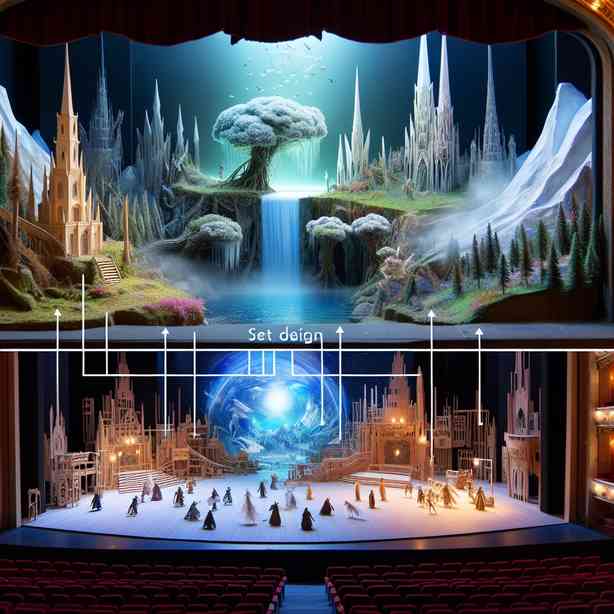
When the Set Design Becomes World-Building
In the realm of visual storytelling, set design often serves as the backdrop for the action, playing a crucial role in establishing the mood and tone of a production. However, when executed artfully, set design transcends its functional purpose and evolves into a complex form of world-building. This transformation from mere decor to immersive environments is not only essential for the audience’s suspension of disbelief but also enriches the narrative itself.
Set design, at its core, involves not just the aesthetic arrangement of physical space, but also the creation of an atmosphere that reflects the themes and emotions of the narrative. Imagine entering a space meticulously designed to evoke a particular era or vibe—each prop, color scheme, and texture combines to form an emotional tapestry that encapsulates the story. A well-designed set can encapsulate time and place, turning a mere stage into a vivid world in which characters can live, love, and experience challenges.
An example of effective set design as world-building can be seen in period dramas. Here, every detail is painstakingly recreated to ensure authenticity. The types of furniture, wall textures, lighting fixtures, and even fabric patterns contribute to the overall narrative. When the audience sees meticulously crafted sets that transport them to another time, they are more likely to believe in the world the characters inhabit. This belief is fundamentally important, as it allows the audience to engage deeply with the characters and their journey.
Moreover, set design can also introduce audiences to fantastical worlds devoid of historical constraints. In genres like science fiction and fantasy, set designers face the challenge of creating entirely new reality constructs. For instance, the iconic sets of movies like “The Lord of the Rings” and “Star Wars” demonstrate how intricate design can establish a narrative’s universe. The fantastical landscapes, alien environments, and imaginative structures are not just visually stunning; they also communicate the mythology and societal structures of those worlds. Each set reveals something about the inhabitants and their cultures, thereby enhancing the overall depth of storytelling.
Furthermore, the importance of cohesive design emerges when multiple elements come together to form a world. Set designers often collaborate with writers and directors to ensure that each set piece aligns with the characters’ arcs and the story’s progression. For example, a character’s environment often mirrors their psychological state or growth throughout the narrative. If a character starts in a gloomy basement, and gradually moves to a brighter, more open space, the set design reflects their emotional journey. This visual cue adds an additional layer of understanding for the audience, deepening their connection to the characters.
Lighting is another critical aspect of set design that complements world-building. A well-lit space can evoke different emotions and themes within the narrative. Think about horror films, where dim, flickering lights create an atmosphere of suspense and unease. Conversely, bright, vivid lighting can transport audiences to a whimsical fantasy realm or a joyous moment in a romantic comedy. By manipulating light, set designers have the power to influence how the audience feels about the story unfolding before them.
The integration of technology in set design has further extended the possibilities of world-building. With the advent of digital sets and augmented reality, creators can craft environments that were previously unimaginable. This innovation allows for more extensive world-building opportunities without the constraints of physical space and resources. In productions like “The Mandalorian,” the use of LED volume technology has enabled dynamic backgrounds that change with the story, seamlessly blending real and digital elements. This merges the physical experience of set design with the flexibility of digital storytelling, creating an entirely new form of immersive experience.
Sound design also plays an integral role alongside set design in creating an immersive world. When combined with visual elements, sound can deepen the audience’s experience and transport them further into the created world. Ambient sounds, such as bustling city life or serene nature, enrich the atmosphere. These auditory cues inform the setting and can evoke specific emotions that complement what is visually presented on screen.
As world-building through set design evolves, so do the ways in which designers must think about and approach their work. Designers must consider not just the physicality of the space but also how that space interacts with narrative themes, character development, and the overall emotional journey of the audience. The ability to visualize a setting that encapsulates the essence of the story brings forth an environment ripe for exploration and connection.
In conclusion, when set design becomes world-building, it significantly elevates the narrative experience. By creating immersive environments that reflect characters, themes, and emotions, set designers can transport audiences to new realms where stories unfold. Whether through historical authenticity, fantastical landscapes, or innovative technology, the art of set design enriches storytelling by making the world felt on a profound level. This symbiotic relationship between set design and world-building ultimately allows audiences to engage more deeply with the narrative and the characters within.
It is essential for creators, producers, and audiences alike to recognize the importance of set design as a transformative agent in storytelling. As visual and immersive narratives continue to thrive, let us appreciate and acknowledge the meticulous planning and creativity that push the boundaries of what is possible in set design, turning simple backdrops into vibrant worlds bursting with life and potential. Through thoughtful design, the once-static nature of a set can bloom into a full-fledged universe that captivates and resonates, enriching the art of storytelling for generations to come.


